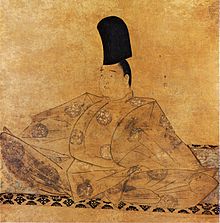Fujiwara no Nobuzane
Fujiwara no Nobuzane ( Japanese 藤原 信 実 ; born 1177 , died 1266 ) was a Japanese court painter of the Kamakura period .
life and work
Nobuzane's father was Fujiwara no Takanobu (1142–1205), a pioneer of realistic portrait painting, which then became typical of the Kamakura period. Nobuzane was tutored by his father and continued this tradition, painting mainly at the request of the emperors or the retired emperors. He painted individual portraits, but also group pictures of meetings at court. In doing so, he brought the detailed and lifelike visual art developed by his father to perfection , which at the time was famous as nise-e ( 似 絵 ).
Records mention that Nobuzane portrayed the resigned Emperor Go-Toba in 1221 , shortly before he was exiled on the island of Oki . Other reports mention a portrait of the priest Hōnen and self-portraits. The image of the resigned Go-Toba ( 後 鳥羽 院 像 , national treasure) that is kept in the Minose Shrine ( 水 無 瀬 神宮 , Minose jingū ) in Osaka Prefecture could be that of 1221.
Among Nobuzane's group pictures there is one from 1218, which shows a gathering in the palace Seiryō-den ( 清涼 殿 , Seiryō-den ) within the Imperial Residence in Kyoto. This palace was dedicated to the fine arts such as painting, music and poetry. The scroll with the name “ Meeting in the Palace” ( 中 殿 御 会 , Chūden gokai ) has only survived as a copy. Nobuzane also portrayed a trip that Go-Toba took as a group picture. There is a copy of this picture from the Muromachi period .
Nobuzane also painted fictional portraits of famous people from the past, such as that of the Thirty-Six Immortals of Poetry , starting with Kakinomoto no Hitomaro . The Satake edition of Thirty-Six is believed to provide a good idea of Nobuzane's style of painting. There are also good reasons that the “Imperial Equestrian Guard ” ( 随身 庭 騎 , Zuishin teiki ), which is owned by the Ōkura Art Museum , came from Nobuzane.
Nobuzane also excelled as a poet. The collection of his poems came to us as Nobuzane ason shū ( 信 実 朝臣 集 ). He also received the Ima Monogatari ( 今 物語 ) font collection .
literature
- Suzuki, Toshihiko (Ed.): Fujiwara no Nobuzane. In: NIhon daihyakka zensho (Denshibukku-han), Shogakukan, 1996.
- Tazawa Yutaka: Fujiwara no Nobuzane. In: Biographical Dictionary of Japanese Art. Kodansha International, 1981. ISBN 0-87011-488-3 .
Web links
| personal data | |
|---|---|
| SURNAME | Fujiwara no Nobuzane |
| ALTERNATIVE NAMES | 藤原 信 実 (Japanese name) |
| BRIEF DESCRIPTION | Japanese court painter of the Kamakura period |
| DATE OF BIRTH | 1177 |
| DATE OF DEATH | 1266 |

